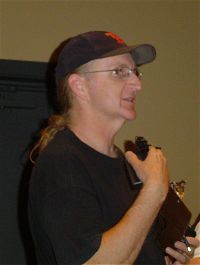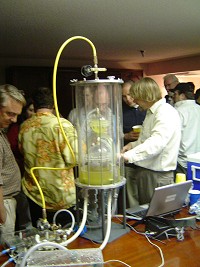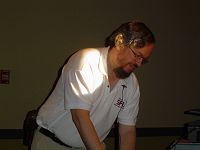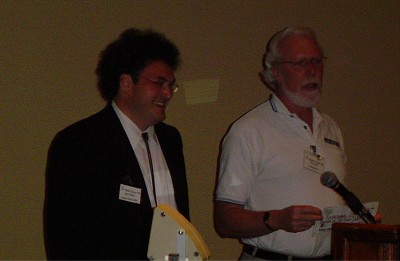|
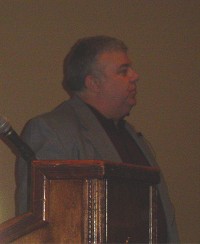
Jess Sponable of the AFRL/VA, Wright Patterson AFB
Jess, who has worked in RLV areas for many years (including
DC-X), began with a preview of the
Responsive Access to Space Technology Exchange (RASTE)
2006 meeting sponsored by the Air Force Research
Laboratory (AFRL). It will take place July 18-19 in
Dayton, Ohio.
He then began discussing DARPA's Falcon Program:
Small Launch Vehicle (SLV). It is managed by the
Air Force and he is the Program Chief Engineer for the
program. The objective is to demonstrate "affordable
and responsive space lift". Task 1 is the SLV,
task 2 is hypersonic technologies.
Began with 9 Phase 1 contracts, 4 Phase 2A, and now
2 SLV. SpaceX (which is paying for most of its own expenses)
plus Air Launch LLC. Air
Launch would fly in 2008 if Phase 2B approved.
Air Launch QuickReach rocket development completed
Phase 2A on time, on budget. This included engine tests,
stage separation test, ground drop test, C-17 drop test.
Self-pressurizing propellants (Propane), no secondary
pressurization system, no venting inside aircraft, single
engine each stage, thrust vector control (TVC). Drops
will eventually be done at 500ft/sec at 30k ft. Fires
after about 3 seconds.
Tests needed to prove practical implementation. There
were initial doubts about drops from C-17 but the tests
went very smoothly. Try to use as much off-the-shelf
technologies as possible.
Rapid prototyping approach. Phase 2A was accomplished
in 11 months at $11M. Phase 2B major milestone 1 already
met with separation test. Shape charge cuts tank to
unsheath second stage engine. Milestone 2 engine tests
also done. Need to do full-scale stage two engine qualification.
More drop test and other items remain.
Mr. Homans
discussed the New Mexico Spaceport. He promoted NM as
a space industry friendly area. Plans to attract entrepreneurial
space companies to NM go back several years. Involved
with Scaled and Virgin before X PRIZE was won. Early
on they decided to pursue the XP Cup very aggressively.
Environmental impact review and other regulatory processes
are moving along well. Looking for architectural and
construction firms that are aware of the significance
of the first purpose built commercial spaceport. Want
an impressive facility that inspires awe. Should attract
visitors who come just to tour the spaceport and not
just flight participants. Will work for both horizontal
and vertical launch systems. Initally manned horizontal
and small unmanned vertical.
The political and business communities in NM are strongly
behind the push to attract and nurture this industry.

Armadillo
Aerospace next gen design.
John begins with review
of their development history. Here are miscellaneous
notes:
- Philosophy is to build actual hardware, make multiple
versions to experiment and learn about them.
- Experimented with pumps but don't think they are
needed for suborbital
- Will use spherical tanks for the next generation
of vehicles
- Fixed date for an event like the XP Cup is a good
motivator for getting things done.
- Built an ablative engine for the XP Cup vehicle.
- Did 20 flights before last year's Cup. Everything
looked very solid going into the event.
- High winds led to the toppling after landing on
the first flight off the ground plate. This caused
a fuel leak that prevent a second flight. They learned
a lot in preparing the vehicle for the Cup.
- Have applied for license for a larger vehicle. Not
complete.
- New vehicle is a scaled up version of previous one.
Gimbeled engine. 100 gallon tank.
- Test stand now uses same systems as on the vehicle.
Fully tests what will fly.
- Film cooled engine. Little or no erosion.
- Video of horizontal firings. 30 ft plumes.
- Trying to talk rocket racing people to try vertical
drag racing as a side event.
- Picture of intermediate test vehicle. Will go for
the lunar lander challenge at next XP CUp with it.
- Showed cool video of a hold-down test this week
of a large vehicle. Tested gimbaling. No erosion in
long burn.
- Graphic of large vehicle for high altitudes. Returning
to differential throttling. Engines on side and body.
Totally sealed body design. Could do water launch.
Aiming for Level 2 Centennial Challenge. Capable of
manned flights to 100km.
- Expects to lose them during tested. Fairly inexpensive
to build. (~$30k)
- Hopes to reach 100km by end of this year. Next year
lots of flight tests.
- NM is a long drive. Hope to use private land near
home in Texas.
- Orbital system feasible for $2M range.
- TSTO, low performance first stage, high performance
second stage.
- Currently focused on bi-propellant but thinking
of the possibilities of a monopropellant for a SSTO
vehicle. Something they will investigate and perhaps
build a test system.
- Hope to get some commercial customers to fly payloads
to 100km this year to pay for development.
- Since their construction costs are so low, only
a few flights needed to pay for a vehicle.
Chuck gave an update on
the Rocketplane development:
- Now pursuing both suborbital and orbital systems
- Rocketplane XP design now at a "mature"
stage.
- Lots of wind tunnel testing. About 700 runs at Mach
4. Checks CFD
- Using a RS-88 from NASA for testing. Will be derated
to 36k lbs thrust.
- Combined design and assembly teams under one roof
in Guthrie.
- Working with Sprit Wing Aviation, which is very
experienced with LearJet vehicles.
- First XP wing nearing completion.
- Showed ground track of the flight.
- First approved supersonic flight corridor outside
of military installations.
- Rocky Mountains and Gulf of Mexico will be visible.
- Will usually fly in the morning. Will see terminator
over Rockies.
- Will try a night flight eventually.
- Hope to develop the spaceport ground facilities
for terrestrial tourism, e.g. a theme park.
- Can take out two rear seats and fly payload modules
for experiments.
- Expect eventually to fly in foreign locations such
as Hokkaido in Japan.
- Kistler
K-1:
- 75% complete
- Basis of COTS proposal.
- Military applications
- Integrating same team as when project suspended.
- At system level, there is considerable overlap
between the orbital and suborbital vehicle development.
- With a COTS contract they could fly by 2008.
First commercial flight in 2009.
- Will try to develop K-1 even without COTS but
it will be delayed.
- Suitable for Bigelow habitats / America's Space
Prize.
- K-1 based lunar transport scheme shown from
several years ago. Used a heavy lift version of
the K-1 with a cluster of first stage boosters
for putting fuel and cargo into orbit.
Rick and Bill
presented the Foundation's new Teachers
in Space project. The goal is to fly hundreds of
teachers to space every year. Will first try to raise
money from private sources.
Armadillo, Rocketplane, and XCOR have each agreed to
provide one free ride as their vehicles come on line.
- Jeff reviewed
MSFC and Michoud facilities and what's available for
companies to test their systems. Full cost accounting
has been dropped (i.e. don't have to pay the whole cost
of a wind tunnel to use it.) Space Act agreements require
up front payments. Trying to make the process more customer
friendly and useful.
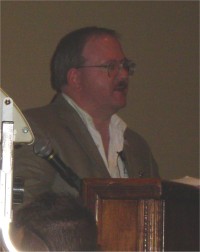
- Jeff Greason reviewed
the status of the XCOR projects. (To show how he sees
the future, he briefly put on a pair of sunglasses.
- 25 employees now
- 2000 - $100k revenue
- 2001 - EZ Rocket, $300k revenue
- $1.1M business in 2005
- Expect $3.5M revenue in 2006
- Propulsion systems and components: rocket engines,
composite LOX tanks, pumps, valves, etc.
- Complete rocket vehicles:
- X-Racer
- sub-orbital vehicle - need private operator
- Suborbital passenger flights - use a Value Added
Reseller (VAR) model
- LOX tanks
- Standard epoxy-fiber suffers from micro-cracking
in the epoxy.
- Jeff was familiar with fluropolymers (related
to Teflon) from time at Intel and suggested trying
it for tanks.
- Doesn't burn and doesn't suffer from micro-cracking.
- Patent pending.
- NASA materials R&D is being cut way back
so XCOR's project will probably also be cut.
- Lots of interest for both aerospace and other
apps.
- Need to go as far as capped tanks with internal
funding
- Pumps - piston pump project. Will use a three cylinder
pump for the X-Racer engines.
- LOX/Methane propulsion development started long
before NASA talked about using it for the CEV. When
NASA included it in the Exploration architecture,
they applied for the contract. Met most of the long
term requirements already with a working thruster
but still lost the contract to a company with only
paper designs. However, methane propulsion was dropped
from the architecture but it might be brought back.
- EZ-Rocket - For the XP Cup it was brought out of
retirement and they got cost/flight down from $3000
to $900 and turnaround from 24 hour to 3 hour
- X-Racer - first flights this year.
- Pump-fed LOX/Kerosene. 1500lbf
- 10 minute turnaround
- 16-20 sortie/day.
- ~1.5 km/s delta-V
- There will be 10 independent owner/operators
- Need to work out warranty, insurance, support,
etc issues.
- Will be a big deal as far as building up the
industry infrastructure
- Xerus suborbital vehicle
- Despite all the other projects, they still have
2-3 people working full time
- Have half of funding now to build the Xerus.
- Progressing but can't say more
- Several job openings.
- George reviewed progress in commercial space
launch in the past year since the last SAS meeting:
e.g. XP Cup, Rocket racing League formation, SS1 installed
in Smithsonian, SpaceShipTwo development underway, Centennial
Challenge suborbital competitions, NASA's commercial
ISS resupply program, Space Adventures Explorer suborbital
projects in UAE and Singapore, NM spaceport, Falcon
1 launch attempt, etc.
At AST there have been several developments as well.
They worked, for example, on streamlining of environmental
impact reviews. Provide standard template documents
for horizontal and vertical launch vehicles. Ultimate
goal is to obtain a Categorical Exclusion for launch
vehicles, which would release launch vehicle developers
from the need to do environmental reviews. Need more
flight data to obtain that.
Human spaceflight rulemaking underway. Currently reviewing
public comments made on the proposed rules.
Experimental permit for RLV available. Used to fly
vehicle for R&D, showing compliance for license,
and crew training. Permits valid for one year. No "for
profit" or paid passenger services.
He expects several experimental permits this year,
an RLV license, and a new launch site operator license.
Also, he thinks there will be frequent, routine suborbital
passenger flights within 2-3 years.
- Dave gave an update
of progress at MSS since last year.
- Igniter development and tests went well last year
- They then moved to start full engine development.
- Showed videos of the tests, including a 45 second
firing.
- Fully regenative cooled chamber.
- LOX/Isopropyl Alcohol
- XA-01 vehicle photo.
- Hold down tests in couple of weeks.
- Tether tests probably by June.
- Cansats and small payloads.
- 350gram CanSat - $99
- Expect to fly at XP Cup
- This team tracks
down high altitude rockets flown by amateur teams and
small companies. Experienced in particular with the
Black Rocket Desert but have also done, and will do,
searches in other areas.
Launch recoveries include:
- CSXT 100km flight in 2004
- Two AeroPAC To100K flights by Aero-PAC (Association
of Expt. Rocketry of the Pacific) that attempted to
reach 100K feet. Both had second stage problems. More
attempts planned for this summer.
- Paragon Dragoon IIB - shovel recovery
- Installed an amateur radio repeater at Black
Rock.
- UP Aerospace launch at the NM spaceport this summer.
[Update: Here are the slides
from Ian's presentation.]
- Barbara reviewed space weather, which deals
with the solar wind, flares, solar radiation, aurora,
etc. Relevant to the commercial space transport industry
with regard to such issues as radiation exposure for
suborbital and orbital space tourists.
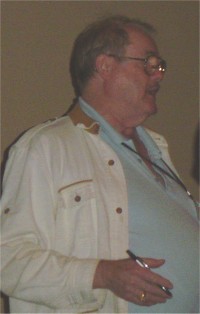
Jerry Pournelle
- Jerry lays out his suggestions
for space development. "The quickest way to space"
is for Congress to pay $10B to the first company to
establish a lunar colony with at least 31 people and
"keep them there alive and well for 3 years and
1 day". No income tax would be paid on the prize.
He proposes $5B for a "space station continuously
occupied by 12 Americans for 3 years and one day".
Return to the X program model. A successful X program
should last about 4 years, no new technologies, three
vehicles (one to crash, one to test, and one to the
Smithsonian), and aim to "push the envelope".
Jerry recounted his involvement in the effort to start
the SSX
single stage to orbit vehicle. The DC-X became the prototype
for the SSX. This would have evolved into the DC-Y,
which would have gone to orbit or close to it.
- Timothy reports on what the
company has been up to during the past year. One project
came out of last year's meeting: they got a contract
to develop the attitude control system for the Masten
Space XA-01.
They are also working on the Viper
engine - pressure fed LOX/Kerosene, 7500 lbf thrust.
Can be cluster to reach 30k lbf thrust. Cheap, replaceable
ablative liner. Lack of testing facilities stalled development
for about 6 months. Moved to Wyoming to avoid problems
in Colorado and moved in a former Atlas missile silo!
Lots of great pictures of the silo facility. Lots of
possibilities for testing both vertical and horizontal
engines and vehicles using facilities on the grounds
as well. Will offer to lease the facility to private
space companies. Can obtain site waiver for 60 second
flights. Intend to apply for suborbital test license.
Talking to the state about support for a private spaceport.
Considering hydrogen peroxide production if there is
sufficient interest.
-
first customer for the Rocketplane suborbital flight.
Considers herself an adventurer, not a tourist. First
found out about space flights when someone told her
about the SS1 flights, which she went to watch. Met
Chuck Lauer at the Space Frontier Foundation meeting
on the Queen Mary in 2004. Made a contract with him
right there. Has been all over the world. Took a submersible
to see the Titanic.
Wants safety but knows the risks. Wants lots of information
about the system and what the experience will be like.
Will try out simulators, training programs, etc. Wants
catering to family and friends who will share the experience
with her.
She will take a flower with her and release it in zero-g.
Then whenever she sees a similar flower she will re-live
the experience.
- Sam Dinkin, Kevin
Greene, Joan Horvath, Joe Pistritto, and Rand Simberg
- A discussion of fallacies such as
- Tourism doesn't generate wealth
- Throwing good money after bad trying to save it
from going bad. (Sunk-cost fallcy)
- Multiplier effect (a space project will create "new"
jobs)
- Money is spent on earth, not in space (Broken windows
fallacy)
- Spinoff benefits
- Everyone loves space and will pay money for it.
Rand gives a brief economics tutorial explaining that
services have just as much value as goods.
Joan notes the invisibility of the alt.space efforts.
Must appeal to the public in some way, e.g. as underdogs
vs. the big guys.
General discussion of markets, NASA, etc.
|


